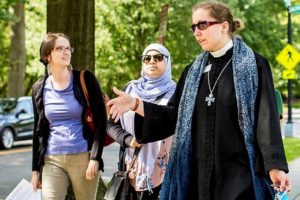By Rev. Carole A Crumley
Some years ago I was in a bicycle accident and broke my left leg at the knee. I went home from the hospital to spend the next six weeks on crutches. I had been accustomed to busy days, working from an office downtown, back-to-back appointments. Being on crutches slowed me down. By necessity, I began to move slowly, walk carefully, pay attention to every step, avoid any potential stumbles. It took me a long time to get anywhere.
During my weeks of recovery, I read Thich Nhat Hanh’s book Peace is Every Step. One of his images caught my attention immediately. He wrote that some people think it is a miracle to walk on water. In fact, I had wondered about that story in the Christian gospels for a long time. (Mt 14:25-26) Nhat Hanh suggested that the real miracle is to walk on the earth with awareness and attention.
He surprised me by suggesting that walking in this way was a spiritual practice. Try going for a walk, he wrote, with no agenda, no destination, no hurry. Just walk. Be alive to the miracle of walking, attentive to each step, open your senses to all that is around you. Stop and linger with anything that catches your attention. Each step is a present moment, a wonderful moment, he wrote.
Being on crutches did not always seem like a wonderful moment to me. However, Nhat Hanh’s suggestion reminded me of what, in the South, we call “moseying”. It’s a slow way of walking that might include stopping to visit with a neighbor, petting a friendly dog, silently admiring the flowers in someone’s garden, watching children play, moving without hurry. In my busy life, I had forgotten how to mosey.
Nhat Hanh’s perspective lent a grace note to my walking with crutches. It encouraged me to be in the present moment, moving as invited, aware and attentive, moment to moment. The pressure of daily schedules seemed to drop away. Instead of impatience with slowness, I realized that while it might take longer to get somewhere, the going was grace-filled.
Holy scripture reminds us that it is “in God that we live, move and have our being.” (Acts 17:28) Thus our physical movement itself is a spiritual discipline, a way of moving that can strengthen our realization of God’s active, inviting presence in the moment. In the midst of the busyness of life, covered over by meetings, deadlines, relationships and commitments, it’s easy to forget that there is a graced way of moving; easy to forget how to mosey; easy to miss the grace along the way.
Perhaps that is why pilgrimage is a vital spiritual discipline in all major faith traditions. Sikhs, Hindus, Jews, Buddhists, Muslims, Christians, as well as others – honor pilgrimage as a part of their tradition. It is one of the many places where we find common ground in our interfaith community. As one pilgrim wrote, pilgrimage is the art of slowing down, not speeding up. “On pilgrimage”, another one wrote, “we are both moving with God and toward God, trusting God on a path that is mysterious and unknown.”
For many years, I have led pilgrimages to Iona, the holy island off the coast of Scotland. One of our signature activities is to walk across the island, following the footsteps of Columba, the island’s founding saint. It is not a forced march but one that invites a prayerful intention. We make this walk come rain or shine.
One year, the walk was done despite gale force winds and drenching rain. While many began the walk, most turned back halfway, soaked, tired and wind-blown. Only a few pressed on determined to walk the whole way. One of those pilgrims had almost canceled coming on this pilgrimage altogether. Her body was so wracked with pain, she wasn’t sure she could make the journey. Yet here she was among the faithful few who had carried on.
“What kept you going?” I asked. Others seemingly stronger, younger, more fit for the walk had turned back. Her answer was simple. “I wanted each step to be a prayer for peace. There is so much need for peace in the world, I knew there had to be many steps. So, I walked on.”
One does not need to go on pilgrimage to distant places to find God, nor does one need to walk to pray. But most of us do some amount of walking each day. Whether in our homes, our neighborhoods, on crutches or in hiking boots, we can move in God attentive ways, move with open eyes and open hearts. Along the way, by some miracle, we may find ourselves surprised by grace.
Rev. Carole Crumley is the retired senior program director of Shalem Institute and former canon educator and founder of the Center for Prayer and Pilgrimage at Washington National Cathedral. A sought-after retreat and conference leader, Carole continues to teach and lead pilgrimages to sacred sites in Europe, the Middle East, and the U.S. Carole is a lover of storytelling, moveable feasts, and country music.

